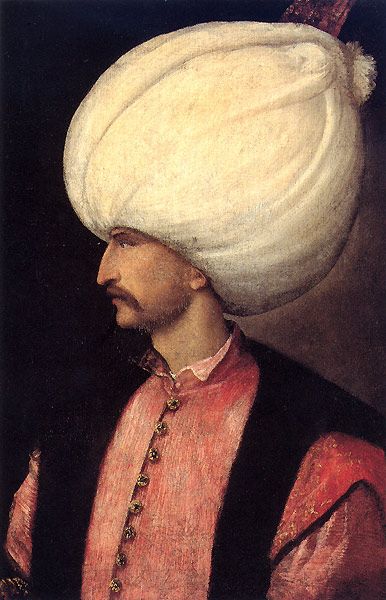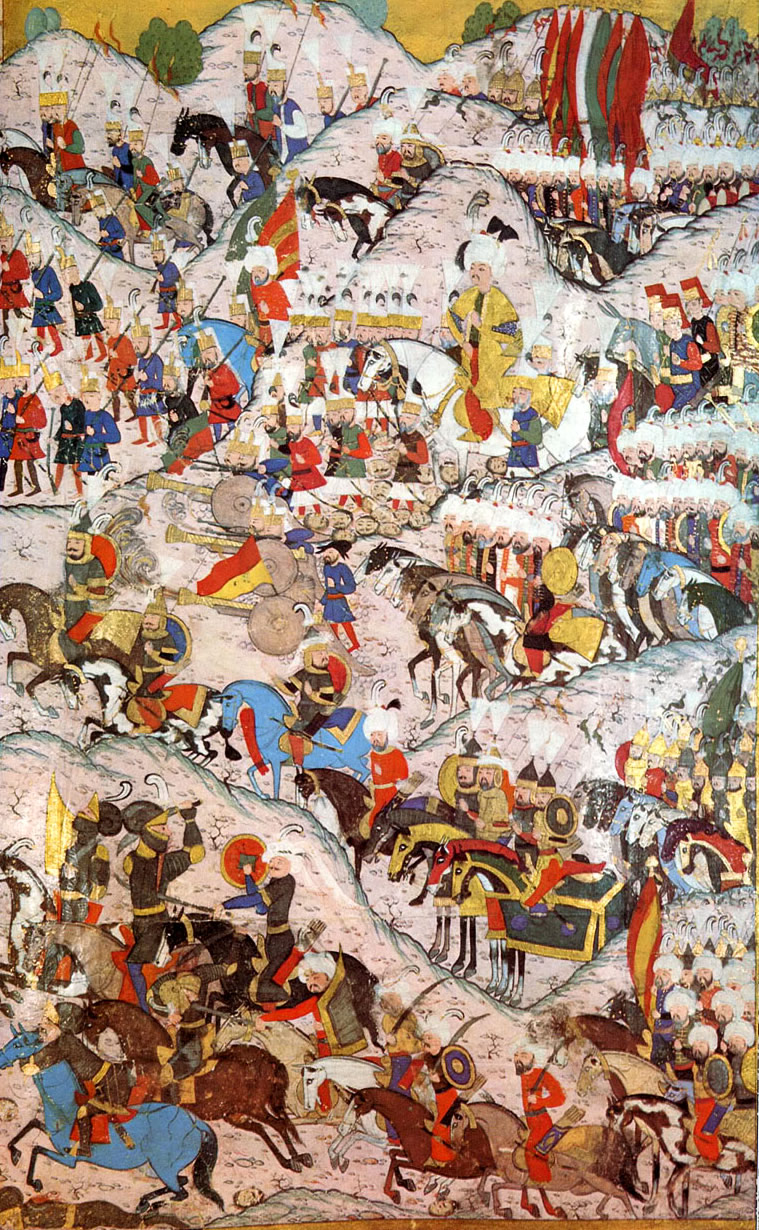World History
Suleiman (r. 1520–66) ruled the Ottoman Empire when it was the most powerful empire on earth. He came to the throne after his father, Selim I (the Grim), had expanded Ottoman territories to the east and west. Although he was only in his 20s when he became the sultan, Suleiman already had experience in the field as a military commander and as an able administrator in Balkan and Crimean territories.
Suleiman was known as “the Magnificent†in Europe, and among his subjects as Kanuni (the lawgiver) for his codification of Ottoman laws. Known for his fairness and honesty, Suleiman granted extensive local autonomy to his far-flung provinces, maintaining close regulation only over taxes and the regulation of trade.
Victory Over European Rivals
In 1527, Suleiman had over 80,000 trained men in military service and with better guns and horsemen than his European rivals, the Ottomans quickly seized Belgrade after the Battle of Mohács and moved on to lay siege to Vienna in 1529.
But Suleiman failed to defeat his main rival Charles V, the Holy Roman Emperor, or to take Vienna. As the Ottoman troops retreated from the city they were reputed to have left sacks of coffee, already popular among the Ottoman urban elite and a commodity that would soon enjoy widespread favor in the west as well.
Although Suleiman also failed in the attempt to take Malta, he ruled all of the Balkans and Hungary, as well as most of the territory around the Black Sea, the eastern Mediterranean, Egypt, and much of North Africa. He rebuilt the walls of Jerusalem, parts of which still stand.
The Austrian diplomat Ogier Ghiselin de Busbecq described in lavish detail the grandeur of the Ottoman court under Suleiman. Europeans praised Suleiman’s serious demeanor and culture, as well as his ability to discuss literature and philosophy in several languages.
A contemporary of the other great monarchs of the age, Charles V of Spain, Francis I of France, and Henry VIII of England, Suleiman made practical alliances with Francis I to counter the power of Charles V and was a major participant in European diplomacy.
Marriage
Suleiman married a favorite slave from Russia, Hurrem Haseki (The Joyous One), known in Europe as Roxelana. Suleiman was deeply in love with Hurrem, and he wrote her moving love poems under the penname of muhibbi (beloved).
However, Hurrem, as well as her mother-in-law and a rival wife, became powerful political forces in their own right and plotted ruthlessly for their particular favorites to become Suleiman’s successor. Hurrem outmaneuvered her rivals so that her favorite son, Selim II, would become sultan. Believing Hurrem’s allegations about intrigues by his more capable sons, particularly Mustapha, Suleiman ordered their murders.
Suleiman was devastated when Hurrem died and had the famed Ottoman architect Abdul-Menan Sinan build a magnificent mausoleum in her memory. Sinan also designed the massive Suleimaniya complex in Istanbul as a lasting monument to the great sultan.
Although already in his 70s, Suleiman again led his troops into battle in what became another failed attempt to take Vienna in 1566. After the ailing Suleiman died on the battlefield, his commander kept the death a secret from the troops, who kept on fighting, until Suleiman’s son, Selim II, had been safely installed as the new sultan. Selim inherited an empire at its zenith of power but failed to equal his father’s distinction as either an administrator or military leader.
- Koprülü Family
Koprülü Family Four different members of the Koprülü family served as grand viziers in the Ottoman Empire during the 17th century. Of obscure Albanian origins, Mohammad Koprülü had a fairly inauspicious career in the vast Ottoman bureaucracy...
- Battle Of Mohács
Battle of Mohács The Battle of Mohács, which erupted in the summer of 1526, was a major Ottoman victory over the Hungarian king Louis, marking the end of the Jagiellon dynasty. Led by Suleiman I the Magnificent, the Ottoman troops, estimated at...
- Ottoman Empire
Ottoman Empire The Ottoman Empire was a centralized absolute regime ruled from the top by the sultan. As in other nomadic and Islamic empires, the Ottomans never developed a legal procedure for accession and this was to be a source of instability and...
- Ottoman-safavid Wars
Ottoman-Safavid Wars The protracted conflict between the Ottomans and the Safavids was based on territorial and religious differences. Both great empires sought to control vast territories in present-day Iraq, along the Caspian and their mutual borders....
- Abdul-menan Sinan - Ottoman Architect
Abdul-Menan SinanSinan was born in Kayseri in central Anatolia to a Greek Orthodox family. When he was in his early 20s, older than was customary, he was recruited in the devshirme levy to be educated in Istanbul. He was selected for the elite Janissaries...
World History
Suleiman I the Magnificent - Ottoman Sultan
 |
| Suleiman I the Magnificent |
Suleiman (r. 1520–66) ruled the Ottoman Empire when it was the most powerful empire on earth. He came to the throne after his father, Selim I (the Grim), had expanded Ottoman territories to the east and west. Although he was only in his 20s when he became the sultan, Suleiman already had experience in the field as a military commander and as an able administrator in Balkan and Crimean territories.
Suleiman was known as “the Magnificent†in Europe, and among his subjects as Kanuni (the lawgiver) for his codification of Ottoman laws. Known for his fairness and honesty, Suleiman granted extensive local autonomy to his far-flung provinces, maintaining close regulation only over taxes and the regulation of trade.
Victory Over European Rivals
In 1527, Suleiman had over 80,000 trained men in military service and with better guns and horsemen than his European rivals, the Ottomans quickly seized Belgrade after the Battle of Mohács and moved on to lay siege to Vienna in 1529.
 |
| Suleiman I the Magnificent in the Battle of Mohács |
But Suleiman failed to defeat his main rival Charles V, the Holy Roman Emperor, or to take Vienna. As the Ottoman troops retreated from the city they were reputed to have left sacks of coffee, already popular among the Ottoman urban elite and a commodity that would soon enjoy widespread favor in the west as well.
Although Suleiman also failed in the attempt to take Malta, he ruled all of the Balkans and Hungary, as well as most of the territory around the Black Sea, the eastern Mediterranean, Egypt, and much of North Africa. He rebuilt the walls of Jerusalem, parts of which still stand.
The Austrian diplomat Ogier Ghiselin de Busbecq described in lavish detail the grandeur of the Ottoman court under Suleiman. Europeans praised Suleiman’s serious demeanor and culture, as well as his ability to discuss literature and philosophy in several languages.
A contemporary of the other great monarchs of the age, Charles V of Spain, Francis I of France, and Henry VIII of England, Suleiman made practical alliances with Francis I to counter the power of Charles V and was a major participant in European diplomacy.
Marriage
 |
| Hurrem Haseki |
Suleiman married a favorite slave from Russia, Hurrem Haseki (The Joyous One), known in Europe as Roxelana. Suleiman was deeply in love with Hurrem, and he wrote her moving love poems under the penname of muhibbi (beloved).
However, Hurrem, as well as her mother-in-law and a rival wife, became powerful political forces in their own right and plotted ruthlessly for their particular favorites to become Suleiman’s successor. Hurrem outmaneuvered her rivals so that her favorite son, Selim II, would become sultan. Believing Hurrem’s allegations about intrigues by his more capable sons, particularly Mustapha, Suleiman ordered their murders.
Suleiman was devastated when Hurrem died and had the famed Ottoman architect Abdul-Menan Sinan build a magnificent mausoleum in her memory. Sinan also designed the massive Suleimaniya complex in Istanbul as a lasting monument to the great sultan.
Although already in his 70s, Suleiman again led his troops into battle in what became another failed attempt to take Vienna in 1566. After the ailing Suleiman died on the battlefield, his commander kept the death a secret from the troops, who kept on fighting, until Suleiman’s son, Selim II, had been safely installed as the new sultan. Selim inherited an empire at its zenith of power but failed to equal his father’s distinction as either an administrator or military leader.
- Koprülü Family
Koprülü Family Four different members of the Koprülü family served as grand viziers in the Ottoman Empire during the 17th century. Of obscure Albanian origins, Mohammad Koprülü had a fairly inauspicious career in the vast Ottoman bureaucracy...
- Battle Of Mohács
Battle of Mohács The Battle of Mohács, which erupted in the summer of 1526, was a major Ottoman victory over the Hungarian king Louis, marking the end of the Jagiellon dynasty. Led by Suleiman I the Magnificent, the Ottoman troops, estimated at...
- Ottoman Empire
Ottoman Empire The Ottoman Empire was a centralized absolute regime ruled from the top by the sultan. As in other nomadic and Islamic empires, the Ottomans never developed a legal procedure for accession and this was to be a source of instability and...
- Ottoman-safavid Wars
Ottoman-Safavid Wars The protracted conflict between the Ottomans and the Safavids was based on territorial and religious differences. Both great empires sought to control vast territories in present-day Iraq, along the Caspian and their mutual borders....
- Abdul-menan Sinan - Ottoman Architect
Abdul-Menan SinanSinan was born in Kayseri in central Anatolia to a Greek Orthodox family. When he was in his early 20s, older than was customary, he was recruited in the devshirme levy to be educated in Istanbul. He was selected for the elite Janissaries...
